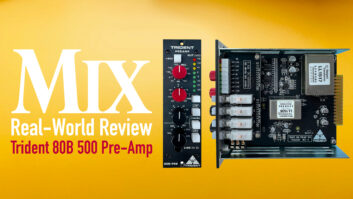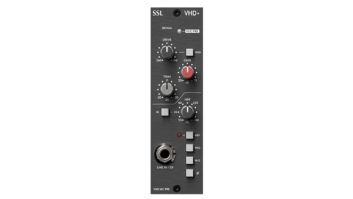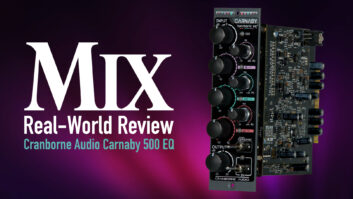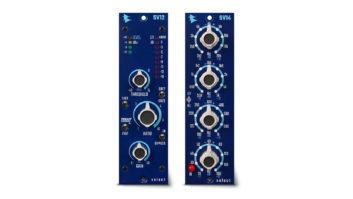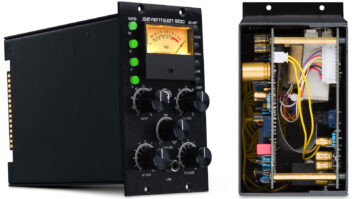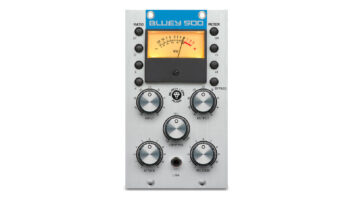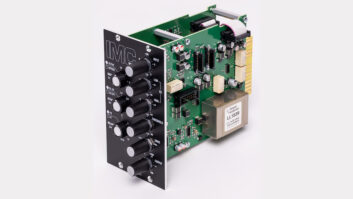
The Electrodyne 501 (left) preamp and 511 EQ modules use the same parts and specs as the original gear.

Since purchasing a Radial Workhorse 500 earlier this year, I’ve been enjoying the range of modules available for the 500 Series platform. I recently had the pleasure of using three products—the Electrodyne 501 preamp, the Electrodyne 511 inductor-based EQ and a pair of the Millennia Media HV-35 preamps—across a range of applications. What’s great about these and most other 500 Series modules I’ve used in session is how companies have gotten so good at squeezing personality and features into such a small enclosure.
ELECTRODYNE 501 AND 511
Electrodyne was started in the 1950s by Arthur Moser and Arthur Davis with the intent of creating high-end portable gear for the motion picture industry. Early products included a modular microphone amplifier, program EQ, mic EQ, and variable highpass and lowpass filters. Intended for field use during production, Electrodyne products were both portable and rackmountable, much like the 500 Series units tested here. In the ’60s and ’70s, the company offered the ACC-1204 15×4 audio console, the ACC-1608 console purposed for 8-track studio recording and the ACC-803 audio control console for sound reinforcement. These offered a pick-a-part design using modules in a variety of colors dependent on their purpose, making it easy for users to identify units visually. It’s in this light that the 501 and 511 were created, using designs and components from these early desks.
The Electrodyne 501 ($895) is a two-stage, transformer-coupled preamp using discrete transistors with direct input based on the classic ACC-1608 console. Performance is optimized using detailed factory-engineering notes from the era, and components are selected with the intention of duplicating the originals’ performance. For instance, the 501’s transformers are made by the original supplier using the original specs.
The 501’s controls are straight ahead and enough to overcome any studio challenges. There is a large rotary gain knob (68 dB) adjustable in 2dB steps. There is a smaller output level completely variable from infinity to +6 over zero. Other controls include a DI/mic switch, two-way impedance switch (50 or 200 ohms), -20dB pad, polarity flip and a 48V phantom-power switch with a welcome confidence LED. There is also a single red LED that flashes when signal is present and gets brighter and stays solid when any stage is 3 dB from clipping or higher.
The Electrodyne 511 EQ ($1,050) is a simple, 2-band, discrete transistor, inductor-based equalizer using design technology from Electrodyne’s early consoles. As with the 501, the 511’s custom inductors and output transformer are made by Electrodyne’s original provider to strict factory tolerances. While simple in design and control, this EQ is incredibly musical. The frequency control is a slick, small rotary metal pointer just outside the gain knob that points to the chosen band. The upper control offers 12 dB of equalize/attenuate at 1.5k, 3k, 5k and 10k, while the bottom features the same cut and boost at 50 Hz, 100 Hz, 200 Hz and 500 Hz. Both can be either bell or shelf. The only other control is the EQ in/out button, which has a confidence LED.
I first used the 501 and 511 in tandem on a kick drum and later a snare drum. While the combination is not a must, the pairing was sweet anywhere I used it. On kick drum with a Shure Beta 52 placed inside about four inches from the head, the 501 didn’t wince at the input gain from the mic once I kicked in the -20dB pad. Using the Input and Output controls, I was able to tailor the sound by driving the output a bit, giving me a fatter tone. With the 511 next in the chain, I set the frequency to 40 and boosted it quite a bit (+6 to +9 dB) before I got what I was looking for. While I wouldn’t call it subtle, like most inductors the EQ does need quite a crank before it gives you what you want, and that’s not a complaint. Once I got the rest of the kit up and going, I did change the frequency to 100 and had better results on this particular kit. Next I set the upper band to 5k to bring out the beater and boosted it between 4 dB and 6 dB, dialing in the perfect blend of the two. Overall, the 501/511 combo gave me plenty of gain with personality, plus that sweet low thump and beater sound. Next on a snare drum, after I set the gain I dialed in the EQ using the shelf control at the top to bring out the snap of the drum starting at 3k and mixed in the fundamental at 200 Hz, with the lower band set to peak. It made me wish I had two of each unit in this application for use with a drum kit.
Next I used the 501 (without the 511) on a lead vocal recorded with an sE Electronics Voodoo VR2 active ribbon mic. This then fed a Universal Audio LA-2A compressor and then to Pro Tools through CLASP, which uses analog tape for throughput—in this case, a Studer 827. The preamp/compressor combo provided a sweet tone that EQ’d well coming back from Pro Tools. I had an “aha” moment later because I worked the morning session with that vocalist while a golden-eared colleague took the p.m. session using the same mic and signal chain, but not through the 501/LA-2A combo. She later mixed both of our sessions and without knowing what I’d used, said she thought my track had more intimacy and presence. While this could be the compressor, I’d had the same experience on other tracks with the 501 in different circumstances. “The preamp is present without being in your face” is the best way I can say it. While hard to describe, these two offer a unique sonic character that is very appealing.

Millennia Media’s HV-35 preamp offers a DC-coupled Ribbon mode that boosts gain by +10 dB and kills phantom power.
MILLENNIA MEDIA HV-35
I’ve been fortunate to have used and reviewed a lot of Millennia products over the years, including the STT-1 Twin Topology recording channel, the TD-1 half-rack recording channel, the HV3R 8-channel remote-control preamps and now the HV-35 ($799). Millennia is new to the 500 Series game, though now offering both the preamp tested here and an 8-channel converter. While I try not to gush in a review, anything I’ve used from this company has spoiled me, and the HV-35 is no exception. The company gets it right or it doesn’t release it. On the downside, one of the units was damaged in shipping, making the rotary volume control work differently and not as smoothly as the other. But this was never reflected in the audio path and I quickly got over it.
The HV-35 offers a continuously variable gain control, DI input, highpass filter at -3dB per/octave starting at 80 Hz, a DC-coupled ribbon mic +10dB gain boost that disables phantom power, +48V phantom power, polarity flip and a -15dB pad. There are two LEDs: one marking signal present (green) and the other clipping (red). All other buttons are LED lit in various colors for quick confidence.
When I have a variety of preamps from which to choose, including Millennia products, I always save the latter for critical applications where clarity and low noise are a must. Because I had two units, my first test was to gas a pair of Blue Bottle mics over a drum kit. Not only are the mics fantastic, being the early versions with the chicken-head knobs on the power supplies, but the HV-35s got out of the way, providing transparent gain, making the kit sound—for lack of a better phrase—like a drum kit. No wash on cymbal hits, clean transient strikes of the cymbals and a fantastic true stereo picture of the drums. You gotta love that.
On another session, I used the HV-35 to power an sE Electronics Voodoo VR1 mic recording a tenor saxophone with great results. The Voodoo ignores the annoying part of a closely miked horn, rounding out the tone. Once again, the HV-35 gave me plenty of clean gain and confidence when I kicked in the Ribbon Mic boost button. I can’t tell you how reassuring a feature like that is in the heat of a session where you’re using a lot of outboard gear, changing settings, pulling cables, patches and troubleshooting. Being able to look over at your rack and see that glowing red light and knowing there’s no way phantom power can be on is like hot chicken soup on a cold day—love it.
Kevin Becka is Mix’s technical editor.

